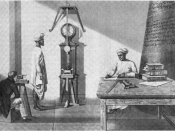Aim
To investigate how the length of a simple pendulum affects the time for a complete swing
Theory
When the pendulum is at the top of its swing it is momentarily stationary. It has zero kinetic energy and maximum gravitational potential energy. As the pendulum falls the potential energy is transferred to kinetic energy. The speed increases as the pendulum falls and reaches a maximum at the bottom of the swing. Here the speed and kinetic energy are a maximum, and the potential energy is a minimum. As the pendulum rises the kinetic energy is transferred back to potential energy. The speed of the pendulum decreases and falls to zero as it reaches the top of its swing, with the potential energy a maximum again.
A small amount of energy is lost due to air resistance as the pendulum swings. This means each swing is slightly smaller than the one before.
There are two forces acting on the pendulum bob. Gravity tries to pull the bob downwards but this is resisted by the tension in the string. As there are only two forces they can only be balanced when they are in opposite directions. This only occurs when the pendulum is in the middle of its swing, so for the rest of the time the two forces are unbalanced; hence the bob swings back and forth.
The two forces are equal and opposite.
This means there is no resultant force on the bob.
It could either be stationary, or passing through the middle of the swing.
force due to gravity = weight of bob = mg
m = mass of bob
g = gravitational field strength
g = 10 N/kg at the Earth's surface
The two forces are not in opposite directions. This means there is a resultant force...



Risk assessment
May i suggest that for your risk assessment, the risks involved would be the possibility that the bob could be unintentionally dropped or swung to hit another person. Also, standard laboratory procedures should be undertaken such as footware.
0 out of 0 people found this comment useful.